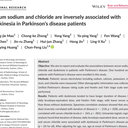Neuroprotective Effects of Paeoniflorin on 6-OHDA-Lesioned Rat Model of Parkinson's Disease.
Słowa kluczowe
Abstrakcyjny
Paeoniflorin (PF) is the main active component extracted from the roots of Paeonialactiflora, a traditional Chinese medicine used for the treatment of neurodegenerative disorders, especially Parkinson's disease (PD). The degeneration of dopaminergic (DA-) neurons in PD may be caused by pathological activation of acid-sensing ion channels (ASICs). Thus, we designed a series of experiments to evaluate the therapeutic effects of PF and to test whether its effects are related to its inhibitory effect on ASIC1a. We found that systemic administration of PF or ASICs blockers (psalmotoxin-1 and amiloride) improved behavioral symptoms, delayed DA-neuronal loss and attenuated the reduction of dopamine (DA) and its metabolites in a rat model of 6-hydroxydopamine (6-OHDA)-induced PD. In addition, our data showed that PF, like ASICs blockers, regulated the expression of ASIC1a, decreased the level of α-synuclein (α-SYN), and improved autophagic dysfunction. Further experiments showed that ASIC1a knockdown down-regulated the α-SYN level and alleviated the autophagic injury in the 6-OHDA-treated ASIC1a-silenced PC12 cells. In summary, these findings indicate that PF enhanced the autophagic degradation of α-SYN and, thus, protected DA-neurons against the neurotoxicity caused by 6-OHDA. These findings also provide experimental evidence that PF may be a neuroprotectant for PD by acting on ASIC1a and that ASIC1a may be involved in the pathogenesis of PD.




